1841
6th June –
NATIONAL CENSUS. was carried out by an appointed Registrar General at National level, unlike previous ones which had been devolved to each locality.
It was thus described as the “first modern census”, as it was also the first one, where the head of each household was now responsible for enumerating details of his family.
The national population was estimated to be 16 million, with 36% under 15 and only 4% over 65.
The population of Skelton was just 628 with 300 males and 328 females.
133 males and 138 females were under the age of 20.
602 had been born in Yorkshire and only 26 elsewhere.
The number of inhabited houses was 146 over a large Parish.
LIVING CONDITIONS.
The Rev J C Atkinson, a local historian, describes visiting local cottages just after this time:-
‘We then went to two cottage dwellings in the main street.
As entering from the street or roadside, we had to bow our heads, even although some of the yard-thick thatch had been cut away about and above the upper part of the door, in order to obtain an entrance.
We entered on a totally dark and unflagged passage.
On our left was an enclosure partitioned off from the passage by a boarded screen between four and five feet high, and which no long time before had served the purpose originally intended, namely that of a calves’ pen.
Farther still on the same side was another dark enclosure similarly constructed, which even yet served the purpose of a henhouse.
On the other side of the passage opposite this was a door, which on being opened gave admission to the living room, the only one in the dwelling.
The floor was of clay and in holes, and around on two sides were the cubicles, or sleeping boxes – even less desirable than the box beds of Berwickshire as I knew them fifty years ago – for the entire family.
There was no loft above, much less any attempt at a ‘chamber’ ; only odds and ends of old garments, bundles of fodder and things of that sort and in this den the occupants of the house were living’.
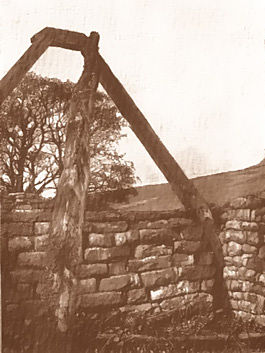
around an inverted timber V at each end.
He describes the sleeping arrangements at a farm near Kilton Castle:-
‘What I found was one long low room, partitioned off into four compartments nearly equal in size.
But the partitions were in their construction and character merely such as those between the stalls in a stable, except that no gentleman who cared for his horses would have tolerated them in his hunting or coaching stable.
These four partitioned spaces were no more closed in the rear than the stalls in an ordinary stable, and the partitions were not seven feet, hardly six and a half in height, while the general gangway for all the occupants was along the open back.
The poor woman said to me, as she showed me the first partition, allotted to her husband and herself and their two youngest children, the next to their children growing rapidly up to puberty, the third to the farm girls, and the fourth to the man and farm lad,
“How can I keep even my children clean when I can only lodge them so ?.”
FROM MITCHELL’S ‘VICTORIAN BRITAIN’
There were on average 274 infant deaths per 1000 births due to the lack of sanitation, medical care and public health measures.
In city slums the figure was 509 per 1000.
Over half of all children of Farmers, Labourers, Artisans and Servants died before reaching their fifth birthday, compared to one in eleven among the Landed Gentry.
With no vaccinations for diseases, no water treatment and only primitive methods of food preservation, children suffered from multiple influenza outbreaks, diphtheria, scarlet fever, measles, whooping cough, food poisoning, polio, tetanus and typhoid.
One death in three was attributed to an infectious disease.
It had always been this way, or worse, and it was only in the second half of the nineteenth century that improvements in living conditions began.
And the population explosion, the final results of which have yet to be experienced.

THE HOUSE OF CORRECTION.
Offenders from the Skelton area who were sentenced to imprisonment were taken to the House of Correction at Northallerton.
The Chaplain there states this year –
“The discipline is very different from what it was. One year’s imprisonment seems quite sufficient.
After that there is a marked alteration in the men.
The conduct of the females is bad. Last week they burnt one of the books and made pipes of one of the Tracts to smoke with.”
[Source: From PP 1842 Vol XX Vol 6 of 11 Volumes, Seventh Report of the Inspectors of Prisons].
“The punishment for breaches of discipline are now restricted to close confinement in dark cells for periods not exceeding 3 days.
Whipping, by order of the Court is generally inflicted on the day of discharge.
The number of lashes is from 13 to 21, the higher number is given to those who are sentenced to be severely whipped. I examined the scourge used.”
Report on Yorkshire Houses of Correction.
1842
31st November –
HARE COURSING.
A match of £5 a side between Mr John Newton’s fawn bitch Bees-wing of Hinderwell and Mr Robert Walker’s black and white bitch, Fly, of Moorsholm. Best of 5 courses.
The coursing took place on the Skelton Estate and the well known qualities of the two dogs excited a great deal of attention and was numerously and respectably attended.
Mr Newton’s bitch won 3 of the first 4 courses.
After the coursing above 40 gentlemen retired to the house of Mrs Jane Lawson, Royal George, where a most splendid and substantial dinner was provided.
THE LOCAL WORKHOUSE AT GUISBOROUGH.
Male and female vagrant wards were erected at the Guisborough Workhouse, first built in 1838.
In these wards, inmates were given a night’s lodging and then required to perform 3 hours work to pay for it.
2 hours before breakfast and 1 hour afterwards.
Women did oakum-picking and men stone-breaking.
“Guisborough appears to have been regarded as a model Workhouse by the Assistant Poor Law Commissioners who visited it.
It had water closets (then a novelty) and a slipper bath.
It had a piggery, a garden field, and a small orchard, and the inmates grew and sold large amounts of potatoes and cabbages.
The Workhouse was well maintained and the inmates, who slept on coconut fibre beds, were regularly shaved, shorn, and provided with Bibles, Prayer books and literature from the Society for Promoting Christian Knowledge.
When it came to work, able-bodied men were required to break half of ton of stone a day in winter, and three-quarters of a ton in summer.
Boys aged 10 to 16 broke a quarter of a ton.
Females were occupied in domestic work or oakum picking.
Boys in the Workhouse attended the local Providence School when they were old enough.
Before the first (unqualified) schoolmistress was appointed in 1846, the girls were taught by a female vagrant.
A local clergyman conducted services in the workhouse dining-hall.”
1843
The Gentleman’s Magazine, Volume XX, July to December 1843 –
May 29th –
DEATH OF JOHN WHARTON. MP. OF SKELTON CASTLE.
In the Westminster-road, Lambeth, in his 78th year, formerly M.P. for Beverley.
He was the eldest son of Joseph William Hall-Stevenson, esq. of Skelton Castle, Durham (son of John Hall, esq. of the same place, who took his wife’s name of Stevenson), by Anne, daughter and heiress of James torster, of Drumgoon, co. Fermanagh, esq.
He was born at Skelton Castle, June 21, 1765, and took the surname and arms of Wharton only, by royal sign manual, May 3, 1788.
He stood no less than nine contested elections for Beverley, on the Whig interest.
The first was at the general election of 1790, when he was returned at the head of the poll, which terminated as follows:
John Wharton, esq. . . 908
Sir James Pennyman . . 460
William Egerton, esq. . 379
In 1796 he gave way to Mr. Tatton, but on that gentleman’s death, in 1799, he contested the seat with Mr. Morritt, of Rokeby Park, but was defeated by 512 votes to 369.
In 1802 he came in at the head of the poll, and Mr. Morritt was excluded, the numbers being –
John Wharton, esq. . . 736
General Burton … 690
J. B. S. Morritt, esq. . 626
In 1806
John Wharton, esq. . .641
Lt..General Vyse . . . 609
Lt.-Gen. N. C. Burton . 420
In 1807
Capt. R. W. H. Vyse . 1012
John Wharton, esq. . . 739
Philip Staples, esq. . . 279
In 1812
John Wharton, esq. . . 805
Charles Forbes, esq. . . 731
William Beverley, esq. . 502
In 1818
John Wharton, esq. . . 826
K. C Burton, esq. . . 669
Dymokc Wells, esq. . . 379
William Beverley, esq. . 34
In 1820 –
George Lane Fox, esq. . 103
John Wharton, esq. . . 657
R. C. Burton, esq. . . 71
In 1826 he was excluded from the representation by the following poll:
John Stewart, esq. . . 1030
C. H. Batley, esq. . . 658
John Wharton, esq. . . 588
At that period Mr. Wharton was so deeply embarrassed in his pecuniary affairs, that he was immediately arrested, and for the last fourteen years he has remained a prisoner within the rules of the Queen’s Bench.
An inquest was held on his body, when it appeared that he bad for many years suffered from a painful disease of the bladder, and an inquest was returned of ” Natural Death.”
Mr. Wharton married in Oct. 1790, Susan Mary Anne, daughter of Major-Gen. John Lambton, of Lambton, co. Durham, by whom he had issue two daughters:
Susan and Margaret, who married in 1815 to Thomas Barrett Lennard, esq. eldest son of Sir Thomas Barrett Lennard, Bart, but died without issue before 1825.
He was succeeded by his nephew, John Thomas Wharton, the son of his third brother, the Rev. William Hall Wharton, M.A., Vicar of Gilling, by Charlotte, daughter of Thomas, first Lord Dundas.
2nd August –
“CARRIER FINED.
“Robert Robinson, of Skelton, Carrier, having the charge of a wagon and a cart in the township of Acklam, on the 2nd of August inst did not keep the same on the Left or near side of the road, ordered to pay a fine of �1 and costs.”
12th November –
“MELANCHOLY SUICIDE”.
[Cleveland Repertory & Stokesley Advertiser.] One of the most awful circumstances that has ever occurred in this neighbourhood was found to have taken place at Skelton.
It appears from the evidence given before John Page Sowerby, Esq. Coroner for the Langbaurgh Division, that early in the morning of Friday the 13th of October, smoke was seen to issue from the chimney of the bed-chamber of Thomas Stephenson Esq of that place, Solicitor.
On the door being forced, the unfortunate gentleman was found enveloped in flames, the bed on which he lay being nearly consumed, and the room filled with smoke.
On examination of the body, the head, face, and left side were very much burnt, and an incision had been made in the throat of about an inch in length and depth.
The razor with which the deceased had effected his purpose lay by his side; his head was resting on his left hand, and the right hand was slightly elevated above his head.
The maid servant, who had lived with the deceased upwards of five years, stated that he had been in a desponding way ever since he left Guisbro� two years previously, and had drunk a quantity of ‘ardent spirits’.
The jury returned a verdict that the deceased had been in a weak state of mind for some time past, and had committed suicide whilst labouring under a temporary fit of insanity.
It is supposed that the deceased had set the bed on fire, and then cut his throat.
Many valuable deeds and papers were found in the coal house! and we are glad to state, for the benefit of interested parties, that the professional documents are uninjured.

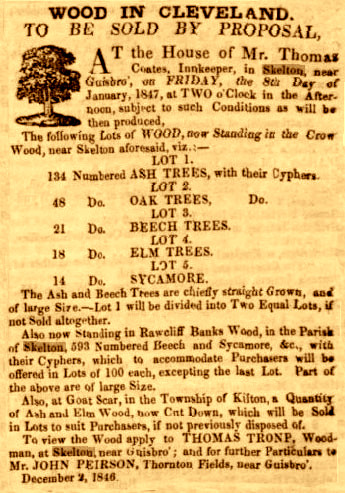
1844
SKELTON TITHES MAP of this year. Click here.
21st May –
SKELTON BECK AND FISH POND.
Desirous of knowing the contents of the beck at Saltburn between the dam head and the sea, I availed myself of the opportunity of the netting, annually made by the gamekeeper, Thomas Frank, for supplying Mr Wharton’s pond at Skelton Castle.
The beck was carefully swept with a net sufficiently close in the mesh to take the smallest minnow, stickleback and “jenny-dab” and the following was the result.
Of the salmon trout, all spawned fish, evidently on their way to the sea, upwards of a dozen were seen, or taken and would have weighed had they been in condition from 4 to 7 pounds.
In the net were also taken numbers of smolts or salmon trout fry etc”
9th July –
3 ON TO 1 VIOLENT ASSAULT.
William Husband, John Husband and Robert Robinson, the younger, all of Skelton, were convicted for violently assaulting William Pierson, the younger of Staithes.
The offence was committed at the township of Brotton.
15th August –
‘ANNUAL RETURN OF LUNATICS – GUISBOROUGH UNION’.
Thomas Bottomley aged 20 years and William Bottomley, aged 16 years.
Both are chargeable to Tocketts and are living with their parents at Skelton in Cleveland.
Their weekly cost of maintenance is 3s each. Both are idiots, harmless, of dirty habits, and both have been of unsound mind from birth.
8th October –
APPLE SCRUMPERS.
James Lowe and David Pallister, Labourers of Skelton, were convicted for stealing apples from a garden in Skelton, occupied by Richard Dixon.
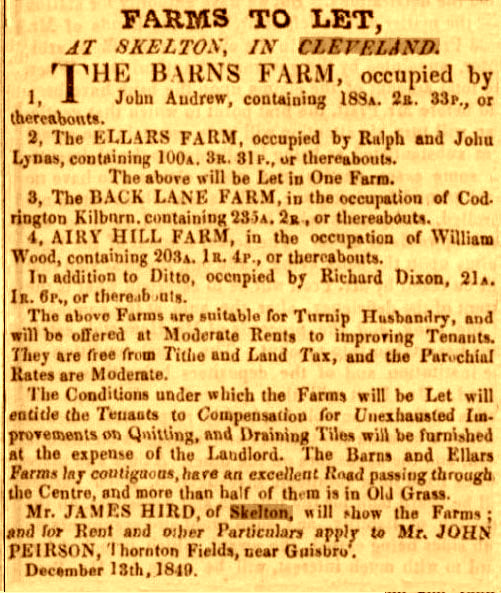
5th November –
VIOLENT ASSAULT.
Thomas Horne of Skelton was convicted for violently assaulting Jane Kell, a singlewoman, also of Skelton.
20th November –
SKELTON INCLOSURE
I, John Humphries, of Ripon, in the County of York, Gentleman, the sole Commissioner named and appointed, in and by an Act of Parliament, made and passed in the Fifty-third year of the Reign of his late Majesty King George the Third, intituled “an Act for Inclosing Lands in the Manor of Skelton in Cleveland in the County of York,” do by virtue of the same Act and of another Act of Parliament therein recited, made and passed in the Forty-first Year of the Reign of his said late Majesty, intitules “An Act for consolidating in one Act certain provisions usually inserted in Acts of Inclosure, and for facilitating the mode of proving the several facts usually required on the passing of such Acts,”
HEREBY GIVE NOTICE
That I intend to hold a Public Sitting at the House of Ann Sowray, the Red Lion Inn, at Redcar, in the said County of York, on FRIDAY, the twentieth of December next, at ELEVEN o’Clock in the Forenoon of the same day, for the purpose of reading over and executing my Award concerning the Lands and Grounds by the said Act, directed to be divided, allotted and inclosed, when and where the proprietors of Estates and Persons interested in the said Inclosure are requested to attend.
Dated this Twentieth day of November, One Thousand Eight Hundred and Forty four.
JOHN HUMPHRIES.
1845
The ‘Enclosure Acts’ were gradually brought into force and areas that had been common land were sectioned off.
The village green in Skelton which had been rectangular and bounded by the present North, South, East, West Terraces and probably used for centuries as free grazing land was reduced to its present size.
Many other wayside grazing sites used for the essential family cow were fenced off as shown below.

6th January –
CLEVELAND HOUNDS.
met at Skelton Castle.
There in the good old English Style was breakfast for all and a more magnificent set out I never beheld.
About 20 of us sat down and after doing ample justice to the good things set before us, we were conducted into an adjoining room, where we partook of various sorts of jumping powder. Fortunately for Mr Trevor assistance was at hand and he and his nag were speedily rescued from a premature grave.
We then proceeded to try for a Fox; Hob Hill and Hazlegrove blank. Had a magnificent find in Saltburn Gill; broke away towards Skelton; turned away past Merry Lockwood’s and right away to Liverton.”
from ‘The Cleveland Hounds’ by A E Pease.
26th July –
TEA PARTY.
A tea party was held on Sunday at Skelton in Cleveland, which was provided by Mrs Wharton of Skelton Castle for the children attending Mrs Lynas’ Sunday School, when a tent was erected for their better accommodation.
1846
STONE COFFINS now in Skelton’s Old Church were found in this year in the Church yard.
5th February –
SKELTON DEBTOR IN GAOL.
London Gazette. The Court for Relief of Insolvent Debtors.
Orders have been made vesting in the Provisional Assignee the Estates and Effects of the following Person on their own Petitions. John Bulmer, late of Skelton, near Guisborough, Yorkshire. Stone Mason.
In the Gaol of York.
14th February –
CORN LAWS.
East Langbaurgh – “This portion of Cleveland is arousing itself in defence of the Corn Laws, an in reprobation of the policy of Sir R. Peel.
Petitions to the Houses of Lords and Commons, deprecating the injustice of Sir R. Peel’s free-trade crotchets, are in active course of signature at Lofthouse, Brotton, Skelton, Liverton, Moorsholm and other places.
[The Corn Laws had been enacted earlier in the century and prohibited the import of foreign corn until the price of home grown reached a certain level.
This state of affairs suited the Landed Gentry and there was a long drawn out battle between protectionists and free-traders before the Laws were finally repealed in 1846.]
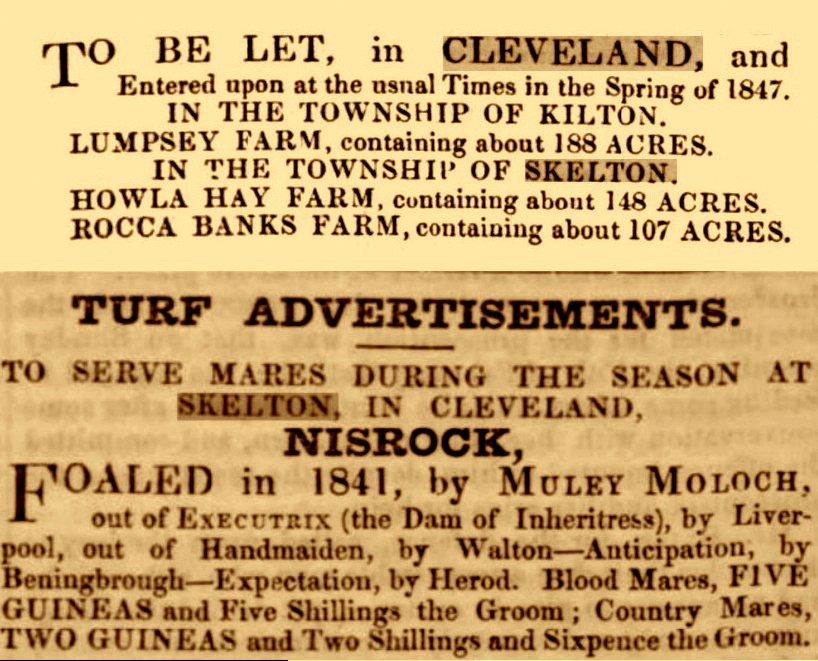
1847
24th July –
SET FIRE TO HEATH.
William Fell, who had been out on bail, was charged with having on the 22nd March last, set fire to a heath at Skelton in Cleveland, the property of John Thomas Wharton.
Fell was the son of a Freeholder in Skelton.
In the 53rd year of the reign of George III [1813] an Act was passed for enclosing the lands of the Manor of Skelton.
A Commissioner was appointed to make inquiries and examine witnesses as to the right of persons living within the boundaries of such manor and he made an award.
A dispute, however, had arisen between the Lord of the Manor and some of the freeholders as to the interpretation of that award.
The prisoner had entertained very mistaken notions about his Right and had set fire to the heath believing he had a right to do so.
Next Assizes steps would be taken to have the dispute legally settled.
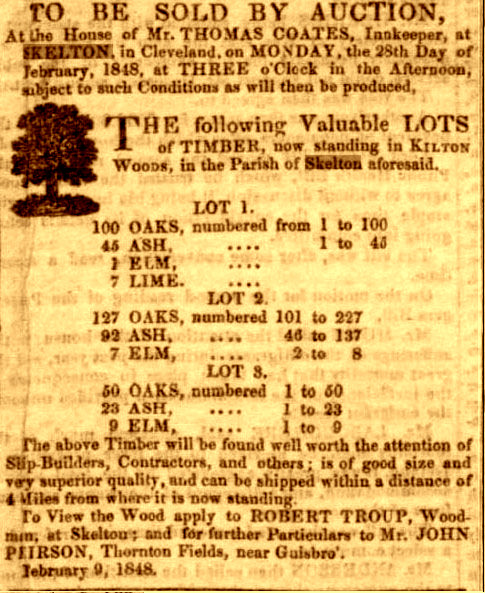
1848
NORTHALLERTON HOUSE OF CORRECTION OVERCROWDED AND INSANITARY.
There had been concern over malnutrition at Northallerton jail, the place to which offenders in the North Riding were committed.
One of the visiting Justices, a Vicar, narrowly avoided censure for having fed meals from the prison to his dogs for 10 years.
There were outbreaks of dysentery and at this time it was found that there were 298 prisoners, but only 68 cells and the corridors and Chapel were being used for sleeping.
Next Page – 1850 TO 1857.
Previous Page – 1824 TO 1841.
Contents Page.